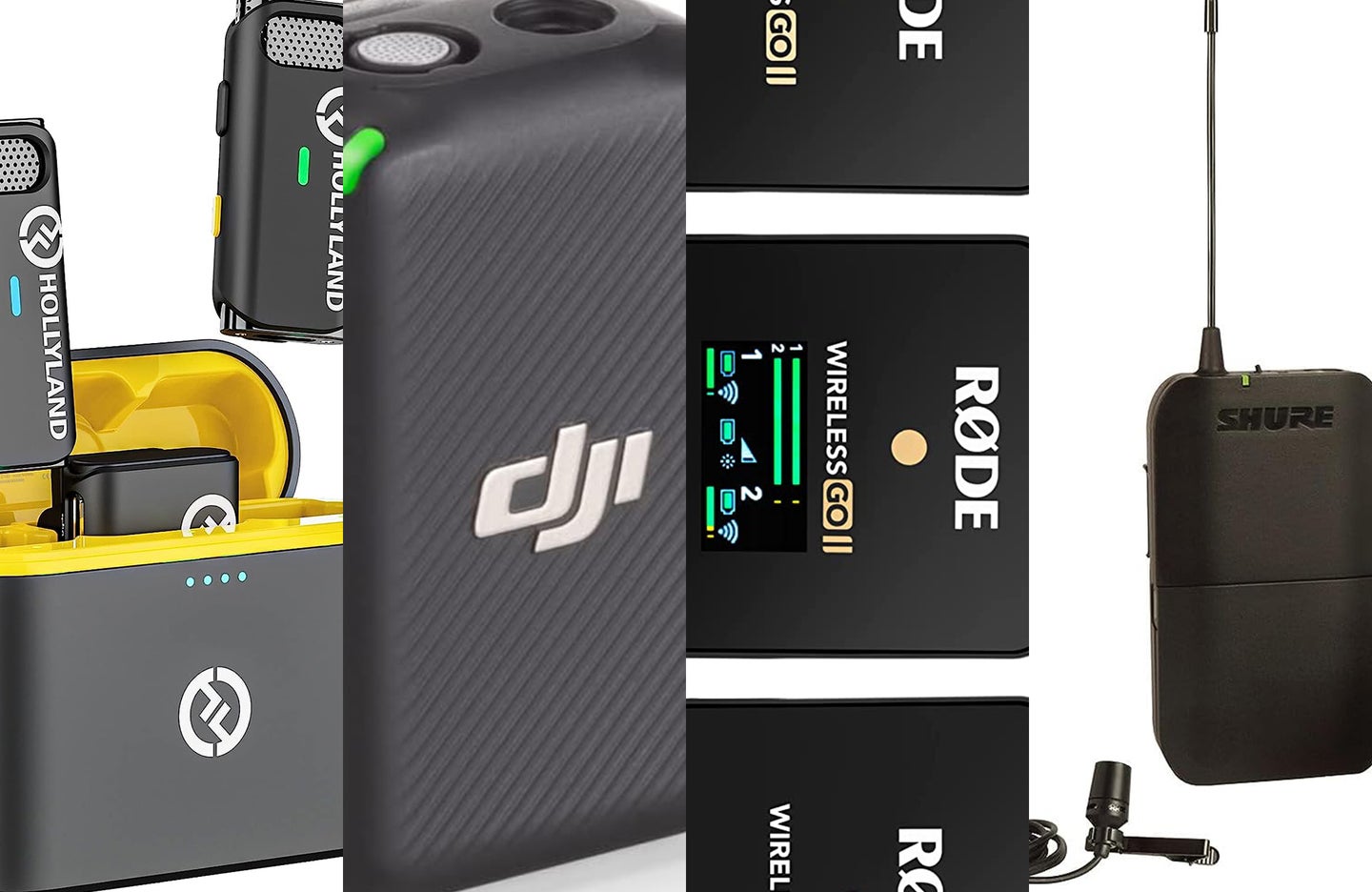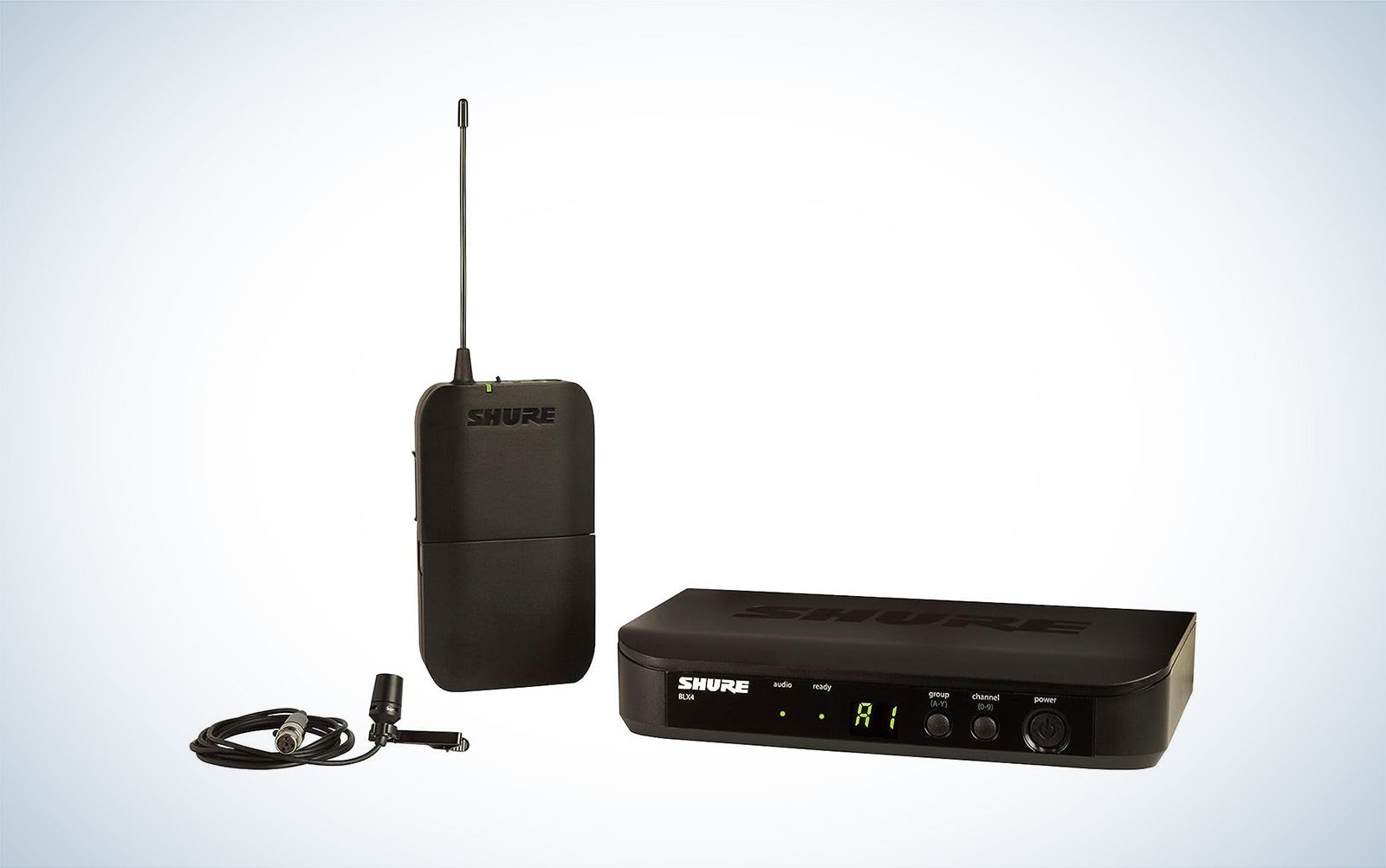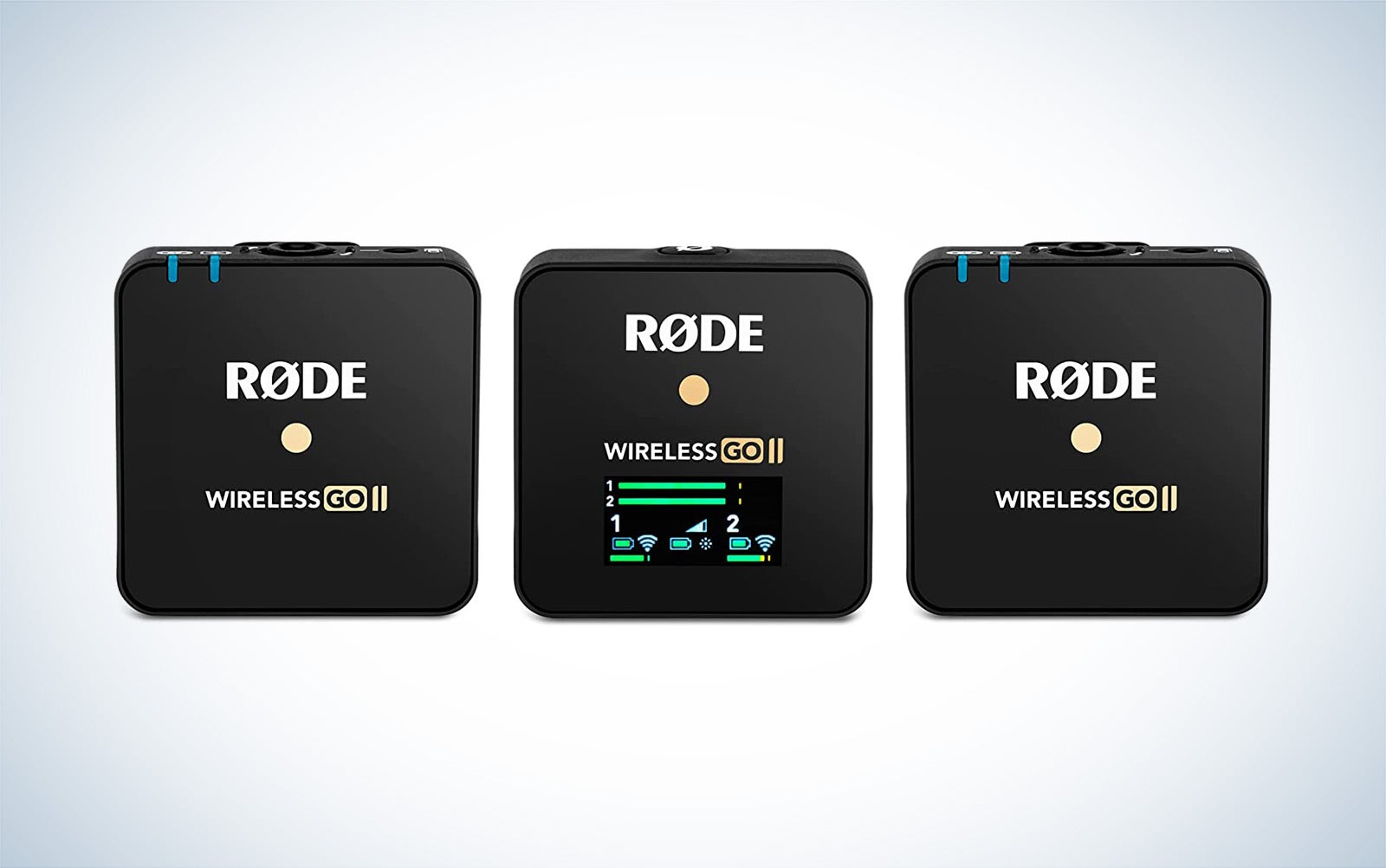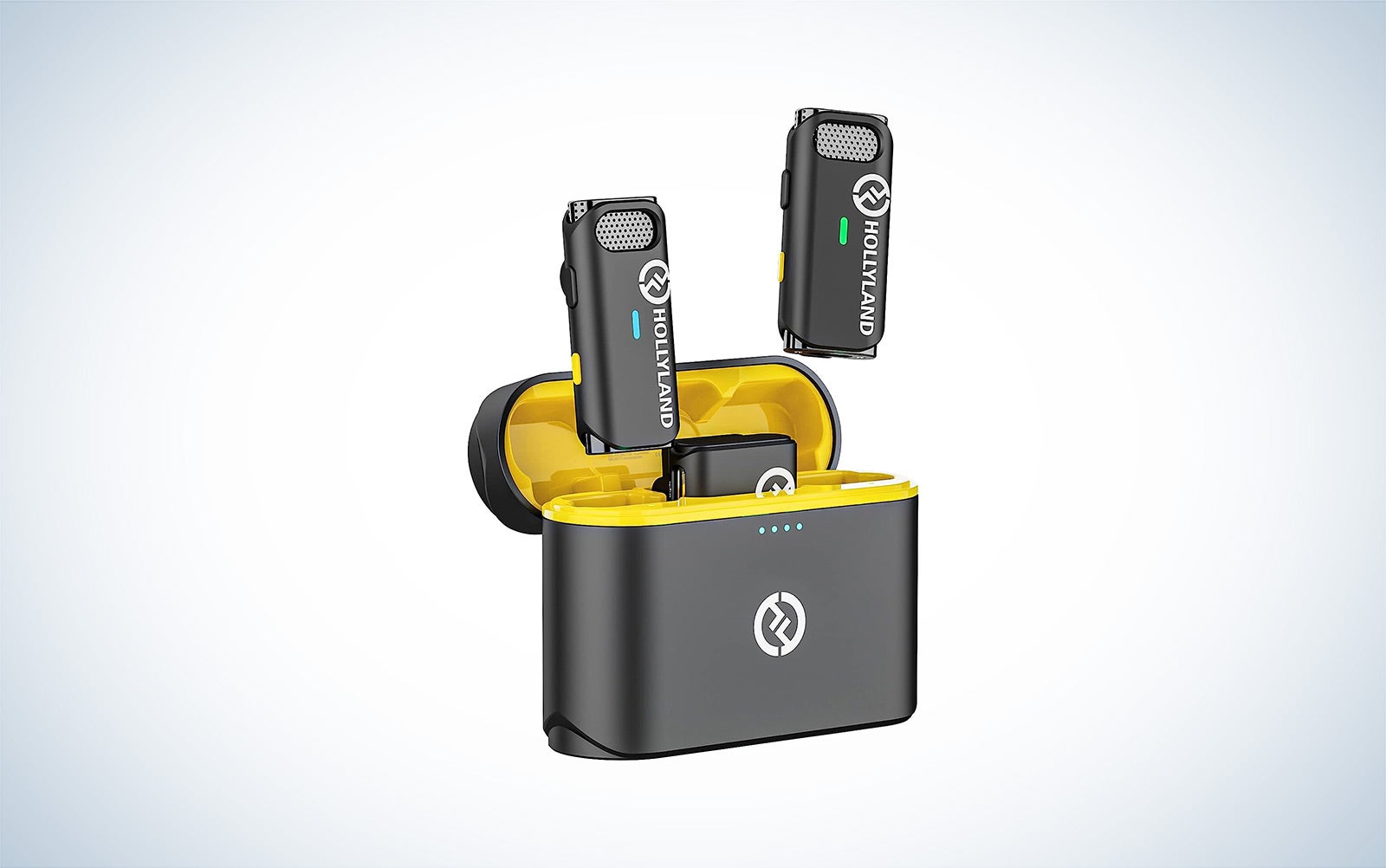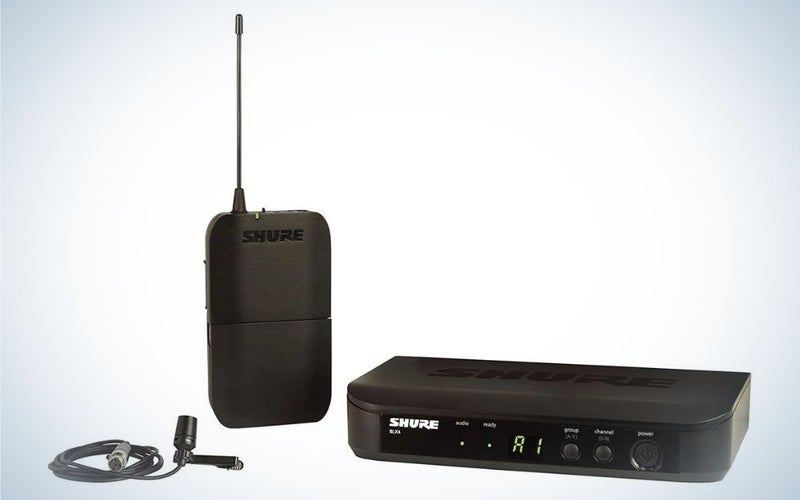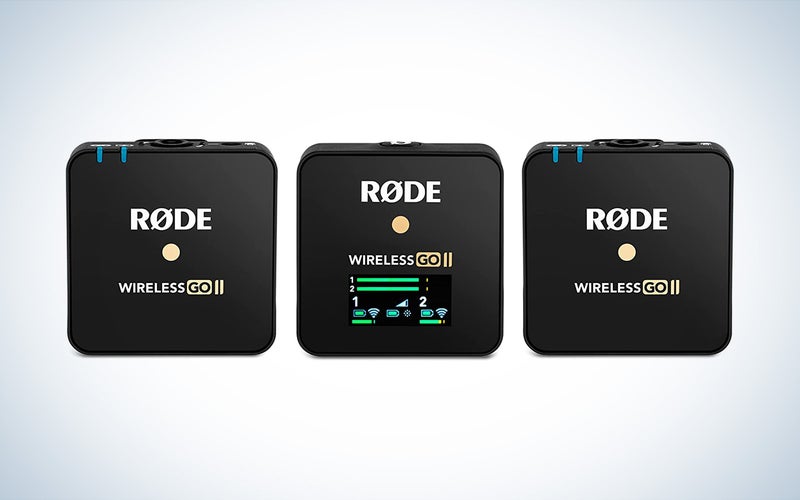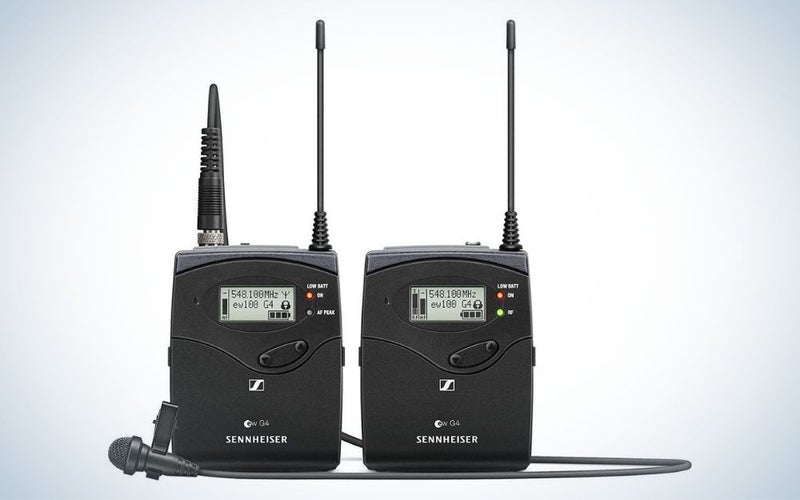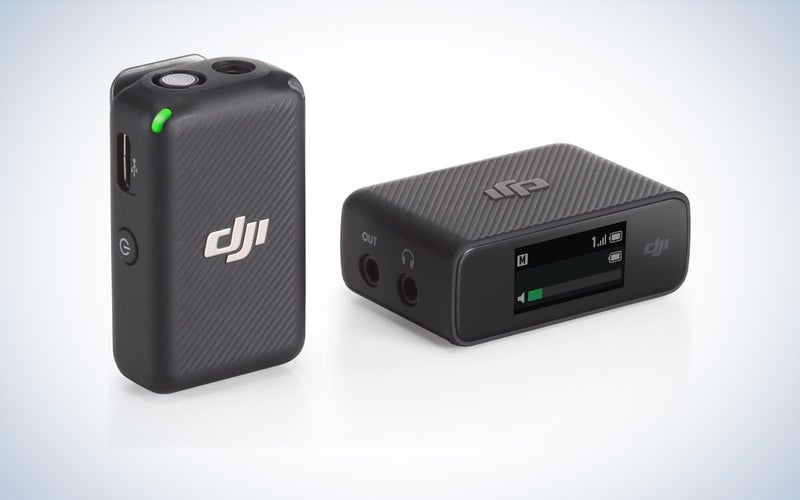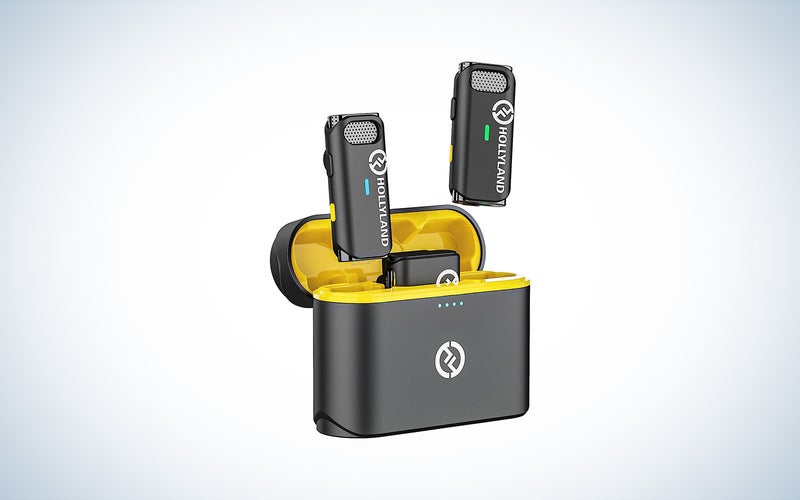We may earn revenue from the products available on this page and participate in affiliate programs. Learn more ›
Wireless lavalier (or lapel) microphones used to be more enticing in theory than they were in reality. Bad sound quality, short battery life, and clunky transmitters made them more of a nuisance than a practical audio solution. However, developments in the technology now allow for great wireless sound, relatively discrete transmitters, and decent battery life. Many broadcasters, vloggers, streamers, and YouTubers use wireless lavalier microphone systems to take the distraction of the clunky handheld or desktop microphone out of the picture. Below are some of our top picks for the best wireless lavalier microphones, as well as tips for what to look for before adding one to your cart.
- Best overall: Shure BLX14/CVL Wireless Microphone System
- Best for vlogging: Rode Wireless Go II
- Best upgrade: Sennheiser EW 112P G4
- Best for long distances: DJI Mic Wireless Lavalier Microphone
- Best budget: Hollyland Lark M1
How we chose the best wireless lavalier microphones
When selecting the wireless lavalier microphones included in this guide, we relied on a combination of hands-on experience, brand knowledge, editorial reviews, and user reviews. We considered key factors such as battery life, build quality, sound quality, features, and compatibility. Lastly, as different situations call for different mics, we aimed to choose options that would work well for a variety of individuals at various price points.
The best wireless lavalier microphones: Reviews & recommendations
Whether you are recording an interview, vlogging your day, or doing a live show, these wireless lavalier microphones will elevate your sound quality.
Best overall: Shure BLX14/CVL Wireless Microphone System
Shure
Specs
- Battery life: 14 hours
- Mics included: 1
- Pickup pattern: Cardioid
- Frequency range: 50 Hz to 20 kHz
- Transmission distance: 300 feet
- Weight: 0.88 ounces (mic), 2.6 ounces (transmitter), 8.5 ounces (receiver)
Pros
- Versatile transmission distance
- Good battery life
- Excellent sound quality
- Available in different frequency bands
Cons
- Only comes with one mic
Shure is one of the most trusted microphone manufacturers of all types, and its wireless lavalier microphone lives up to that standard. The BLX14/CVL offers a 300-foot transmission range, adding flexibility and versatility. And it provides up to 14 hours of battery life via two AA batteries, so you can keep recording for long cuts.
The microphone is compact and discrete, keeping attention on the speaker. It utilizes a cardioid polar pattern to reduce unwanted noise, and the Commshield RF Filtering minimizes RF interference from smartphones. The overall sound quality is excellent, so any speaking will come through loud and clear. The bodypack transmitter is also lightweight and compact, making it more comfortable to wear.
The receiver that comes with this setup is a tabletop design. It features an LED display to show group and channel settings, along with two LED lights that show when it is ready for use and incoming audio signal strength. The main downside of this setup is that it only includes one mic and transmitter, so if you want more than one person to be fitted with a mic, you’ll need to buy extras separately.
Best for vlogging: Rode Wireless Go II
Rode
Specs
- Battery life: 7 hours
- Mics included: 2
- Pickup pattern: Omnidirectional
- Frequency range: 50 Hz to 20 kHz
- Transmission distance: 656.2 feet
- Weight: 1.1 ounces (receiver), 1.1 ounces (transmitter)
Pros
- 3.5mm TRS analog output and USB-C connectivity
- Lots of customization options
- Excellent sound quality
- Plug-and-play design
Cons
- Some settings can only be changed on a computer
Rode is well known for its user-friendly mic systems. The second edition of the company’s popular wireless lavalier mic comes with worthy upgrades and improvements. One of which is a large bump in transmission distance. The mic can now function up to 656 feet away from the receiver, which is ideal for vlogging situations where you aren’t close to the camera. The receiver has also been upgraded to a dual-channel system, making it feasible to use two transmitters at the same time.
The Wireless Go II is extremely easy to use with a plug-and-play design. But there are also lots of customization options should you want to get into the nitty-gritty. That includes an “Always” mode, which begins audio recording as soon as you turn the mic on and lasts until you turn it off. It’s an ideal option for when you need to react quickly to a situation. And there’s a low-sensitivity mode if you are working with loud talkers.
This kit comes with two clip-on transmitters and a dual-channel receiver. It’s a simple, no-fuss setup that provides seven hours of battery life and charges fully in less than two hours. It can record to either its onboard storage or directly to a camera, offering lots of versatility. The compact design makes it an ideal choice for vloggers, run-and-gun videographers, and anyone else on the go.
Best upgrade: Sennheiser EW 112P G4
Sennheiser Pro Audio
Specs
- Battery life: 8 hours
- Mics included: 1
- Pickup pattern: Omnidirectional
- Frequency range: 50 Hz to 18 kHz
- Transmission distance: 328 feet
- Weight: 5.6 ounces (transmitter), 5.6 ounces (receiver)
Pros
- Superb audio quality
- Easy to use
- Rugged, high-quality build
- Comes with a shoe-mount adapter to mount on a camera
Cons
- Expensive
If you’re looking for an upgraded wireless lavalier microphone for higher-end productions, the Sennheiser EW 112P G4 is a fantastic choice. As we would expect with Sennheiser products, it offers excellent, clear audio quality for natural-sounding speaking parts in your videos. It’s ideal for both journalists and videographers alike.
This mic provides a range of roughly 330 feet and eight hours of battery life. It allows you to use up to 12 wireless mics at once, which is ideal for large panel discussions and live events. The all-metal chassis results in a durable build, so you can worry less while recording on-location.
The Sennheiser EW 112P G4 comes with a single mic, transmitter, and receiver. Both the receiver and transmitter feature a daylight-readable LED display, so you can easily check reception quality, battery status, and audio level. And the included shoe-mount adapter allows you to mount it to your camera for convenient use.
Best for long distances: DJI Mic Wireless Lavalier Microphone
DJI
Specs
- Battery life: 5.5 hours from transmitter, 5 hours from receiver
- Mics included: 1
- Pickup pattern: Omnidirectional
- Frequency range: 20 Hz to 20 kHz
- Transmission distance: 820.2 feet
- Weight: 0.21 ounces
Pros
- Extremely long transmission distance
- Quality sound
- Very simple to use
- Effective wind noise filtering
Cons
- A bit pricey
DJI may be best known for its drones, but it also makes a quality, simple-to-use wireless lavalier microphone. The simply named DJI Mic comes with a single clip-on transmitter and camera-mount receiver. It can also be used with a laptop or smartphone, adding versatility. And the receiver features a touchscreen that allows for easy monitoring and adjustments.
The DJI Mic offers a massive range of 820 feet. That’s a big advantage if you are in the field trying to record audio while moving around. The sound quality is excellent, and it comes with a windscreen that effectively filters out wind noise for clearer sound when outside. The transmitter provides 8GB of storage for up to 14 hours of backup recording.
While it isn’t the cheapest option, it provides a lot of quality and versatility for the price. It’s an ideal choice for vlogging, field recordings, podcasts, and general videographer use. And it comes with plenty of adapters along with a case to keep all your items organized.
Best budget: Hollyland Lark M1
Hollyland
Specs
- Battery life: 8 hours
- Mics included: 2
- Pickup pattern: Omnidirectional
- Frequency range: 20 Hz to 20 kHz
- Transmission distance: 650 feet
- Weight: 0.4 ounces (transmitter), 0.6 ounces (receiver)
Pros
- Good audio quality
- Affordable
- Discrete and compact
- Includes a charging case
Cons
- Not compatible with phones without extra cables
It’s easy to spend a lot of money on wireless lavalier microphones, but you don’t necessarily have to. This Hollyland Lark M1 offers quality sound at a much more affordable price than the other options on this list. It comes with a windscreen that does a nice job of filtering out wind noise for clearer audio, even when recording outside. And it offers an impressive 650-foot range.
The Lark M1 provides 8 hours of battery life. And despite the budget price, it comes with a charging case to extend the life of your mic even when traveling. That’s not typical for lavalier mics, so it’s a nice little bonus that those who travel will appreciate. It also comes with a case for keeping all the cables and components together and organized.
The Lark M1 is compatible with most cameras and is extremely simple to use. Of course, with the low price comes some trade-offs. It won’t work with smartphones without purchasing an adapter, and there is no display to check recording mode or battery life. If you want to save even more money, you can purchase a single mic kit for just $79.
What to consider when buying wireless lavalier microphones
There is no shortage of wireless lavalier microphone options available, which can make choosing one challenging. Different recording situations may call for different specs and features, but there are some key things to consider, no matter what type of audio you need.
Sound quality & noise handling
The purpose of a wireless lavalier mic is to obtain better sound quality than what you would get from your camera or camera-mounted mic. So, ensuring you are buying a quality mic is one of the most important factors when choosing which is best. Brands like Rode, Shure, and Sennheiser are all trusted microphone brands that have excellent reputations for high-quality sound.
On top of general sound quality, you’ll want to check how well the lavalier microphone can filter out background noise. Not all options come with a windscreen or similar cover to help filter out things like wind noise, but if you are recording outside, those are very important. A microphone’s polar pattern will also impact how much background noise is picked up.
Battery life
The battery life of wireless mics has improved dramatically in recent years, with most offering at least five hours. If you will only be recording short segments and will have access to power in between sessions, you won’t need to be as considered about battery life. But if you will be out in the field or recording for long periods of time, you’ll want to pay close attention to promised battery life.
Beyond battery life, you may also want to see if a manufacturer provides charging times. Some are designed to charge quickly and get you back to recording in a matter of an hour, while others will take longer. If you need to get back to work quickly, prioritize a mic with a fast charging time. Likewise, some lavalier mics come with charging cases to give you extra power while out in the field, which is advantageous if you travel a lot or are away from power sources.
Transmission distance
The transmission distance of a wireless lavalier microphone will determine how far away from the receiver you can be with the transmitter and mic. If you will primarily be recording talking head videos, where the subject is close to the camera, a large transmission distance won’t be necessary. But if you are documenting something out on location where the subject needs to be moving around far from the camera, be sure to choose an option with a long transmission distance, such as the Rode Go II, which can reach up to 656 feet.
Compatibility
Not all wireless lavalier microphones are compatible with all cameras or devices, so it’s important to verify it will work with what you want to record to before hitting that buy button. Some will only work with cameras and cannot record to computers, phones, or tablets. Others are only compatible with certain types of cameras. Some mics are compatible with all of those devices, but you may need to buy a certain cable or adapter separately.
FAQs
Q: How much is a wireless lavalier microphone?
The price of wireless lavalier microphones varies quite significantly, depending on battery life, features, number of microphones included, quality, and more. You can find options as cheap as $80, or spend upwards of $800.
Q: What is the difference between lavalier and lapel mic?
The terms lavalier and lapel are often used interchangeably, and some mics can even be used as both. However, there are some differences. A lavalier mic is typically slightly smaller and is meant to be completely hidden from view. A lapel mic, on the other hand, is slightly larger and is intended to be clipped directly onto the collar in view.
Q: Is a wireless lavalier microphone worth it?
If you want to record quality audio of someone speaking without being tethered to a device, a wireless lavalier mic is absolutely worth it. Since a lav mic is worn much closer to the speaker’s mouth than a camera-mounted mic, it provides significantly clearer sound, especially when there is background noise of any type. Quality audio is just as important, if not more so, than quality video, so investing in a mic that will provide clear, natural audio is a relatively easy way to elevate your content.
Final thoughts on the best wireless lavalier microphones
- Best overall: Shure BLX14/CVL Wireless Microphone System
- Best for vlogging: Rode Wireless Go II
- Best upgrade: Sennheiser EW 112P G4
- Best for long distances: DJI Mic Wireless Lavalier Microphone
- Best budget: Hollyland Lark M1
While most options are not very cheap, investing in a high-quality wireless lavalier microphone is a sure way to take your content to the next level. Different mics offer various advantages, but as long as you choose one that is compatible with your device, provides quality sound, and offers long enough battery life, your speaking will come across loud and clear no matter what.
Why trust us
PopPhoto has a long history of delivering the opinions of some of the sharpest and most prolific camera dorks the world has to offer. Since 1937, we’ve been reviewing cameras, providing wisdom from well-known photographers, and generally just nerding out about all that goes into making great pictures. Our current crop of writers and editors have decades of professional photography and camera writing experience among them. Collectively, we’ve probably shot with just about every camera and lens combo you can imagine—as well as some obscure stuff you may not even know about. Remember the Casio Tryx folding camera? PopPhoto does.
We also get that buying a camera is a big decision, which is why we’re dedicated to helping folks choose the right one (or, in our case “ones”) for their needs. Case in point: Handing over top dollar for an expensive rig may leave you unsatisfied if it doesn’t fit your preferred shooting style. Sure, a $6,000 sports-oriented DSLR can capture landscapes, but do you really need to do it at 30 frames-per-second? No, you don’t.
